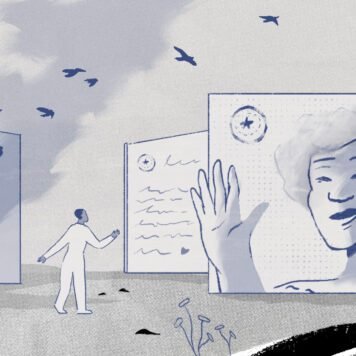If you think about the abiding trends and traits of each decade or generation, the Gen Xers in the 80s had their era of perms and their neon; the millennials in the aughts and teens had their era of whale tails and their indie sleaze, and now we have our era of eras.
Much has already been written about the rapidly cycling nature of trends and microtrends, and how they reflect our particular brand of late-stage capitalism. The language of this branding has seeped into almost every part of our lives, spouted by users big and small on social media sites, casually dropped in everyday conversation, and spurred on by corporations that rejoice in how the marketing landscape has become more simple as people pre-sort themselves into these neat little categories.
At this point, styles such as “eclectic grandpa” or “tomato girl” don’t sell clothing as much as they try to sell a certain lifestyle and character, a rich WASPY summer drinking Cape Codders in Ralph Lauren, or a sleek, sunkissed Rivera summer. They aim to sell us an identity in an ultimate distillation of commodity fetishism. Now, you can buy yourself. The freedom of infinite choice has become a crisis of a you are what you consume mentality.
Trending outfits, outdated gender roles
The issue with this dynamic is that we are not only consuming things to signal our identity and our affiliation to the outward world, but that we are also internalising the aesthetics themselves and all the baggage that goes along with it.
A trend is not just a trend anymore, it is a social role you are asked to play, and a tacit endorsement of the philosophies that underpin it. There is no such thing as just skimming across the top of the surface of the cultural soup. But the most worrying thing about the recent trends that we are consuming now? How much regressive, straight up anti-feminism is embedded in these aesthetics.
The trends I am thinking about in particular, that have floated to the top of our cultural soup, are ones that ascribe women a role linking their sexuality and looks to something plainly economic. Whether it be as a “mob wife” or a “Slavic bimbo” or an “office siren” with a “sprinkle sprinkle” mentality, social media has found a way to reintroduce the language of gender roles for a new generation, limiting the economic agency for women that feminists have fought to redefine for decades to marketable aesthetics dictated heavily by a relationship with male consumption.
Conspicuously gilded cages, or Mob Wives and Slavic Bimbos
Many new aesthetics emphasise the role of a wife as a “kept woman,” one who trades her agency for a luxurious lifestyle. The “mob wife,” for example, is more than fur coats and Italian American mafia trappings: they reenact a woman who has made a seemingly strategic decision to guarantee a life of luxury supported by the criminal affairs of her husband.
However, the role also endorses a relationship where her lifestyle is guaranteed by this proximity to masculine power, and it comes contingent with playing the expected role as a quiet family woman that unconditionally supports her husband. It’s also one that glorifies conspicuous consumption, and ignores dynamics of financial abuse and control: the mob wives of the media, from Carmela Soprano of The Sopranos to the various wives of The Godfather are consistently unable to escape the controlling nature of their husbands and their work.
Similarly, the “Slavic bimbo” which, beyond using a rather derogatory name, recalls this same notion of a “kept woman,” but one where her affection and sexuality can be owned.
The trend recalls the real history of women leaving Eastern Europe through “mail-order” businesses that paired Slavic brides with husbands in the west. Slavic mail-order brides were coveted for their looks, but also for their economic desperation enabling a greater degree of control over them.
Polyester has dedicated a whole article to the “Slavic bimbo” aesthetic, decrying how the “sexed up Slavic woman” embodies a wickedly orientalist paradox: an exotic, foreign woman who is both sexually alluring but committed to traditional gender norms, whose assertiveness and agency is able to be conquered by the west’s financial power. It’s not just blown-out hair and fur hats, it’s a damaging role to assume voluntarily, one that sweeps the very real problems of these women under the rug and distils them into bite-size visions we are meant to aspire to.
HR-violation-core, or the Office Siren
Beyond the role of the wife, microtrends have also come up with a type of acceptable economic agency for women: the “office siren.” The trend references a kind of womens workwear that isn’t a Hillary Clinton pantsuit, more like an early-aughts Miu Miu workwear paired with slim metal-frame Bayonetta glasses, Ugly Betty-style.
Really, there could be a million names for a sensible skirt and button down shirt combo – 90s cubicle-core, J. Crew muse, (Ann) Tayloresque – but the one that the social media ecosystem settled on was one that was heavily sexualised.
The descriptor of a “siren” is a woman who is supernaturally seductive and bewitching. Not only does it reduce the women at work to being a creature of male fantasy, but it also creates a dynamic of tension in the workplace that blames women for luring male attention. I couldn’t help myself! How could a man resist a siren’s song? Grace looked so office siren-like in her blue-light glasses and tweed skirt, and that’s why I’m talking to HR.
“The office siren is just like an embodiment of a mysterious woman who works hard but looks hot and sexy while doing it,” a TikToker described to Business Insider. So, a woman who is smart but silent, a capable worker but also easy on the eyes? Is she a woman, or is she a screen where we project a corporate male fantasy? If we are trying to redefine a woman’s role in the workplace, why are we returning to the past, where women are asked to assimilate into a man’s world on a man’s terms? Rather than clarifying a vision for a future, we only regurgitate the past and its pitfalls.
The trivial is political
Between trying to sell us the sexy secretary look to a post-Me Too generation, and glorifying the materialistic trade of female agency in exchange for a husband’s gilded cage, the greater TikTok subconscious has been working overtime to prime us to regurgitate regressive gender norms.
It’s the newest marketing of a centuries-old hegemonic patriarchal agenda. And while agenda can feel like a strong word to describe “mob wives” and such, it is the right word. Picking an argument over “office sirens” as a feminist issue becomes something I take “too seriously” for ascribing feminist warning bells to something as simple as internet-oriented fancy-dress. But the fact is that it’s not as simple as fancy-dress: what we spend our money on and how we choose to act has always been political. Why should this be different for our personal style and consumption habits?
The popularity of these disempowering aesthetics is part of this agenda, a part that we dismiss and trivialise to avoid looking too closely at how we are vectors of branding. It uses the mouthpiece of our peers who have to rely on the language of the system to interact with it. These messengers, who are primarily young women, operate on an app that encourages engagement in these aesthetics – posting them, citing them, repeating and referencing them again and again – as the only way that their videos will gain traction.
TikTok and other social media sites integrate these aesthetics and buzzwords so seamlessly into the language of the platform that there is no way you can scroll without stumbling into some-core or another. And given its focus on bite-sized branding, it prevents us from thinking critically about what we consume, whether it be the clothes that they model or the wholesale agenda that comes with it. So, we reproduce it. End on end. And eventually, we internalise it.
It is especially concerning given that this content is broadcasted to a huge audience of people, many of whom are children. In the UK alone, 53% of children ages 3-17 report that they use TikTok. Normalising these habits of consumption and the patriarchal messaging that goes along with it for a younger generation threatens to erase generations of radical, liberatory feminist thought.
Subscribe to shado's weekly newsletter
Exclusive event news, job and creative opportunities, first access to tickets and – just in case you missed them – our picks of the week, from inside shado and out.

And our consumption habits are not freed from scrutiny by the fact that women are supposedly the ones with the ability to choose. Choice feminism, the argument that: well, if I choose it and it makes me, a woman, feel good, isn’t it feminist? is not in any way a legitimate cop-out for criticism. Choosing to be in a position of disempowerment is not empowering at all. It doesn’t unsettle and ultimately dismantle the systems of patriarchy and oppression to dress up in the clothes and labels they have given us.
Being “radical” is just as easy as being yourself
It rubs me the wrong way, and I’m sure it frustrates other people as well, to watch women contribute free labour to reproduce repackaged messages of the patriarchy. It’s not comfortable sitting with the fact that the language of marketing has infiltrated into our everyday conversations.
It’s nearly impossible to live with a manufactured pace of change that serves to destabilise us in order to sell us something new to fill the void of identity. But the first part of finding a cure is recognising the symptoms. Only then can we pinpoint what makes us uncomfortable about what we consume, and then alter our behaviour around consumption.
Firstly, you need to remind yourself that you can figure out who you are without the input of Big Brother TikTok. Even if you feel like you can’t, at least start by feeling comfortable with the fact that identities are formed, not found or given. It’s a life-long process, one that changes with time and with experience. It is more natural to feel unsettled in your identity than to be completely happy with it at any one time. Already, doing the work and making the choice to be conscious of yourself is radical. It feels like the mental equivalent of kicking off the reins of the swirling online market of identities and commodities, decluttering our brains to be less susceptible to the incessant clamour of marketing.
Recently, people have been making dents in this market, discussing philosophies such as de-influencing or no-spend November, which seek to break us out of the knee-jerk habit of coveting and consuming. TikTokers like Mandy Lee have pioneered the “75 Hard Style Challenge,” a goal where you commit to buying no new clothes for 75 days as a way to rediscover and style the clothes you already have in your closet. It was only mildly heartbreaking to hear her emphasise that “outfit repeating is fair game,” and feeling a surprising sense of incongruence. A voice in the media telling me it was alright to do what people have done for generations and dress every day in my favourite clothing? Inconceivable!
Others have dedicated themselves to countering these users in their comments sections and in their stitches, questioning language like “siren” and “bimbo” and challenging people to justify their use of such terms as a conscious assertion of their identity. Is it empowering? Can it be divorced from its sexualised history and reclaimed? And is your use of the label effective in its subversion of its baggage?
Only with such pushback can we elaborate to a larger audience what we mean when we use these aesthetics and terms, and also confront ourselves with the question of whether or not they are legitimate tools or simply reappropriated weapons. Being open-minded, curious to learn more, and admitting your blindspots and mistakes is not only the sign of a perfectly working critical consciousness, but necessary for a healthy discourse.
In today’s language of commodity-fetishism, buying critically or rediscovering the potential of your existing closet is almost allegorical for finding your identity with what you already have, returning to a process of self-definition that doesn’t rely so heavily on social or market forces. It’s a habit that asserts an economic independence and agency by refusing the temptation of fast fashion and a culture of consumption. And one that, hopefully, doesn’t elevate the two-dimensional gender roles that we are asked to recycle anew.
What can you do?
- Look into the creators behind the 75 Hard Style Challenge, and maybe take their encouragement to start evaluating your consumption habits.
- A Vox Essay by Lilly Millman might make you feel a little less alone in changing your relationship towards identity, insecurity, and emptying your wallet for a new solution in the form of a product.
- If you would appreciate a historical deep-dive into the link between gender roles and consumption, Victoria de Grazia and Ellen Furlough have compiled a series of essays, The Sex of Things, spanning the Revolutionary War in France to the mid 20th century.
- Michael Serazio’s book The Authenticity Industries uncovers everything that goes into making politics, traditional media, and the marketing industry of social media more and more effective through false relatability.
- Read more articles by Ning HERE









